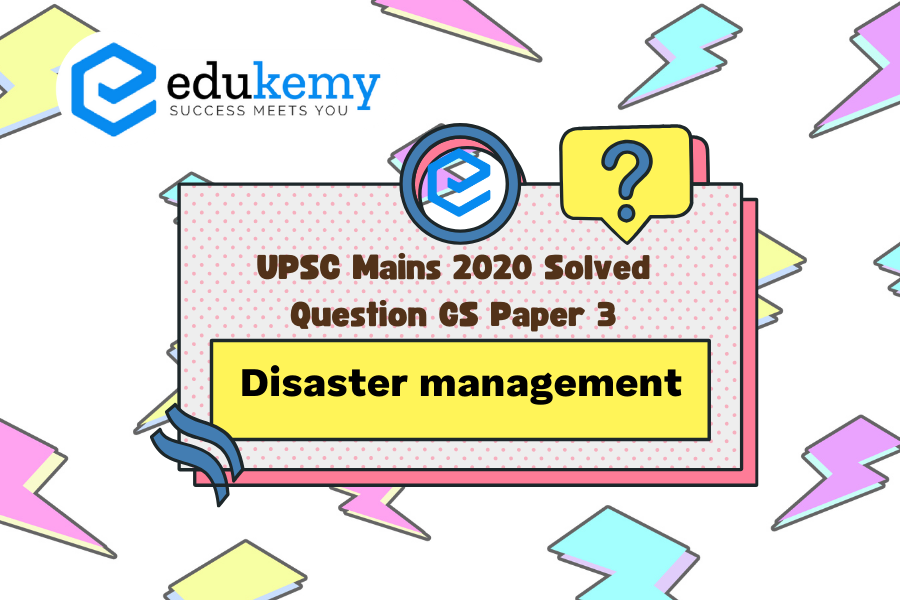In recent years, the Government of India has undertaken significant strides in revolutionizing its approach to disaster management, departing from its earlier reactive stance towards a more proactive and comprehensive strategy. Recognizing the escalating frequency and intensity of natural disasters coupled with the growing vulnerabilities of its populace, the government has initiated multifaceted measures aimed at bolstering preparedness, response, and recovery efforts. Departing from the traditional reactive approach characterized by ad-hoc responses after disasters strike, the government now emphasizes proactive risk reduction, mitigation, and resilience-building strategies. These initiatives encompass a spectrum of interventions spanning policy reforms, institutional strengthening, community engagement, technological advancements, and international collaborations. Such proactive measures signify a paradigm shift towards a holistic approach to disaster management, prioritizing prevention and preparedness as cornerstones of resilience-building. This essay delves into the recent initiatives undertaken by the Government of India in this transformative journey, exploring their efficacy, challenges, and potential implications for enhancing the nation’s disaster resilience.
Tag: Disaster and disaster management.
Contents
Decoding the Question:
- In Introduction, try to write about Disaster and disaster management(DM).
- In Body,
- Discuss the recent measures initiated in DM by the government.
- Highlight significance and challenges of recent measures.
- Try to conclude with the role of recent measures in disaster management.
Answer:
India has been traditionally vulnerable to natural disasters on account of its unique geo-climatic conditions..A disaster is a result of natural or man-made causes that leads to sudden disruption of normal life, causing severe damage to life and property. Disaster in India is managed under the Disaster Management Act, 2005.
Recent measures in disaster management are a departure from the erstwhile reactive approach wherein authorities acted after a disaster had occurred. Such an approach used to focus entirely on rescue, rehabilitation and reconstruction. But recent measures, inter alia, also focus on preparedness, mitigation and adaptation.
Recent Measures Taken In Disaster Management:
Infrastructure: : India presented a practical approach and roadmap with the launch of a global Coalition for Disaster Resilient Infrastructure (CDRI) to make the infrastructure resilient in the face of disasters. It provides member countries technical support and capacity development, research, and knowledge management, to facilitate and encourage investment in disaster-resilient infrastructure systems.
Cyclone Management:
- Cyclone alert: Indian Coast Guard with the assistance of ICG Remote Operating Centres (ROC) and Stations (ROS), NAVTEX warning (Navigational Text Message) and ISN (International Safety Net) activated one week in advance by Maritime Rescue Coordination Centres (MRCCs) prevented the loss of fishermen lives and reduced impact from Cyclone Amphan and Nisarga.
- National cyclone risk mitigation project: The National Cyclone Risk Mitigation Project (NCRMP) has been launched by the Ministry of Home Affairs, with support from the World Bank, in two phases, in the cyclone prone coastal states and Union Territories. The National Disaster Management Authority (NDMA) has been designated as the implementation agency.
- Cyclone warning management: IMD is to launch a dynamic, impact-based cyclone warning system aiming at minimising economic losses. NDMA took up a project named National Cyclone Risk Mitigation Project (NCRMP) in which a Web-based Dynamic Composite Risk Atlas (Web-DCRA) would be developed.
- Partnering neighborhood: To improve existing emergency preparedness and strengthen regional response mechanisms, the field training exercises are conducted, for instance, 2nd BIMSTEC Disaster Management Exercise on flood rescue at the Ramachandi Beach, Puri.
Earthquake: The National disaster management authority released an earthquake zone map for better prediction and monitoring of earthquake zones. NDMA has released a to do and not do list during and after the earthquake.
Floods: NDMA has given detailed guidelines to cope up with floods in general and also Glacial Lake Outburst Floods (GLOFs).
Policy and scheme:
- APADA Mitra Scheme: The NDMA has approved a Centrally Sponsored Scheme focusing on training community volunteers in disaster response in the 30 most flood-prone districts of 25 states in India.
- National disaster management services: The scheme has an integrated approach to provide reliable telecommunication infrastructure to disaster managers during times of non-disasters and in the event of disasters. It is a NDMA pilot project being implemented by BSNL.
In India, disaster management is yet to be seen as integral to development planning. The preparedness at various levels is not people-oriented. India’s capacity to manage disaster risk is challenged by its size and huge population. A scientifically planned adaptation is needed, which will require government support. he transition from Hyogo Framework of Action (HFA) to Sendai Framework for DRR (SFDRR 2015-2013) has brought in the core focus on achieving specific goals, integration of climate change adaptation, environment-disaster linkages, and mainstreaming across sectors of development. The Prime Minister’s 10 Agenda Roadmap on Disaster Risk Management is a big step in this direction.
In case you still have your doubts, contact us on 9811333901.
For UPSC Prelims Resources, Click here
For Daily Updates and Study Material:
Join our Telegram Channel – Edukemy for IAS
- 1. Learn through Videos – here
- 2. Be Exam Ready by Practicing Daily MCQs – here
- 3. Daily Newsletter – Get all your Current Affairs Covered – here
- 4. Mains Answer Writing Practice – here


